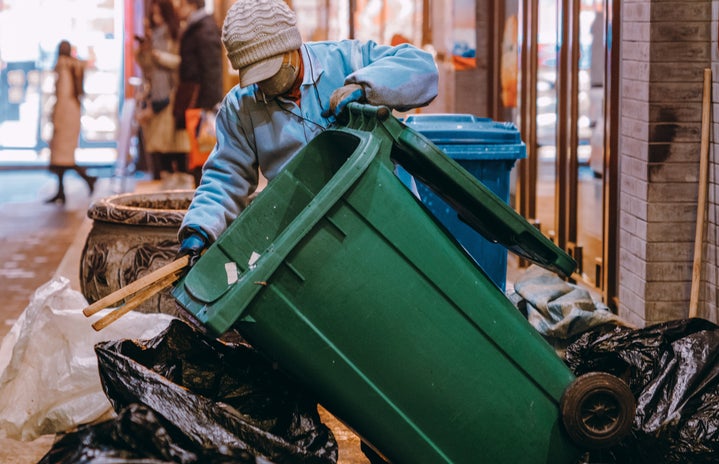As Earth Day rapidly approaches, it is vital to be mindful of the space you occupy on this land and to treat our planet with love, kindness, and respect every day – not just on Earth Day. To all my fellow artists and creators, consider this as a sign to move towards a more sustainable art practice in your daily life by using recycled materials and garbage: this is just one simple way to include a little extra compassion in your craft.
I have been making artwork with whatever I could get my hands on for as long as I can remember. For many artists and activists, saving up money for more expensive tubes of paint and non-synthetic brushes can be a privilege one cannot afford, but it doesn’t discourage them from making. Growing up in a home with financial instability definitely encouraged me to get creative with the materials I used, which often meant using trash, found items, or very cheap art supplies like Dollar Tree brushes and paints. It does not need to cost an arm and a leg to create.
For some people, finding affordable and sustainable materials for artwork may also mean dumpster diving in locations where it is legally allowed to do so. When large corporations continue to produce an immense amount of waste considered “unusable” to the company, it becomes up to individuals with creativity, motivation, and a vision to manipulate those scraps and find a use for them. Like everyone always says, “One man’s trash is another man’s treasure”.
Some of my oldest and fondest memories of painting I have are of using the circular pieces of cardboard that accompany a frozen pizza as my substrate of choice. I think those foundational innovative moments of using trash to benefit me creatively have greatly affected my passion for using recycled and found items in my adult portfolio. Examples of functional garbage that can and should be used in artwork include wrappers of sorts, yarn/fabric scraps, dried flowers/yard waste, old magazines, sheet music, invoices, bottle caps, pop tabs, and pill bottles – the list is quite literally endless. Netted produce bags of different colors are a personal favorite to incorporate into my artwork because they create an interesting three-dimensional aspect to an otherwise two-dimensional piece. If you live in any urban area or college town, it is also common to find litter on daily walks. Keep a close enough eye on the trash and undesired garbage plaguing our planet, and you may find some unique materials to utilize creatively.
The emergence of creative reuse centers is a relatively newer one, and is exactly what the budget-friendly creative community needed in order to make artwork in a way that doesn’t break the bank. Think of creative reuse centers like a thrift store for craft supplies: many items are gently used/well-loved, acquired through donation, and extremely inexpensive. Our beautiful city of Boulder has a terrific creative reuse center called Art Parts which is just off 30th Street and Valmont Road. Art Parts is a terrific little hidden gem store my peers and I frequent to explore the different in-stock materials. Since the supplies are typically through donation, items are constantly being cycled out so each time you visit is a different experience with different supplies.
Unfortunately, many art supplies, such as different painting mediums and solvents, are far from eco-friendly. The manufacturing of many modern oil, acrylic, and watercolor paints contains the addition of microplastics and volatile organic compounds, which can not only be harmful to the person using the paint but also can dramatically impact the environment where the leftover paint water is poured. Disposal is part of the artistic process, and we need to remain mindful of our impacts on the environment after our art has been created. My favorite way to catch and dispose of my paint water is in a large bucket. After enough water has been collected, it is then able to be filtered a few times through a coffee filter and reused for the next project.
It is also possible to make your own watercolor pigments using natural elements found around you in nature, which is probably one of the most sustainable ways to create and use a paint pigment. There is a variety of materials needed in order to create natural pigments; including a muller, silicon carbide, some sort of glass grinding surface, a palette knife, and PPE. These may be expensive upfront but are long-term investment materials which can be used more than once.
Making art is for everyone, but our creativity should not be at the expense of our environment. It is crucial for the normalization and inclusion of trash in artwork to be encouraged moving forward, not only to emphasize artistic experimentation and progression with many challenging materials, but also to prioritize care for the planet in utilizing waste.


